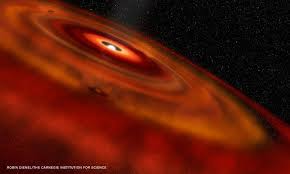This is the first time astronomers using the ALMA radio telescope have seen 3D motions of gas in a disk around a star where planets form. The study published Wednesday in the journal Nature.
The current understanding for planet formation follows a specific order. Stars form from clouds of collapsing gas and dust. Then, a protoplanetary disk of leftover gas and dust surrounds the star. Planets form from this disk, using the leftover gas and dust that created the star to pull together solid material for planets.
This can take place over the course of a few million years as the planets grow from dust rains to round objects with a solid core.
The young star is known as HD 163296. In the disk around it, there are several rings and gaps. Using ALMA, astronomers saw gas flowing into three gaps in the disk, where they would expect baby planets to be.
Although these cascading gas flows have been predicted because they influence the atmosphere of baby planets, this is the first time they've been observed. This gas is the source of their atmospheres.
"We were struck by how dynamic the disk is," said Jaehan Bae, study co-author and Sagan postdoctoral fellow at the Carnegie Institution for Science. "There's a lot going on around this star."
The gaps are located at 87, 140 and 237 astronomical units from their host star. One astronomical unit is equal to the distance between the Earth and the sun.
"What most likely happens is that a planet in orbit around the star pushes the gas and dust aside, opening a gap," said Richard Teague, lead study author at the University of Michigan. "The gas above the gap then collapses into it like a waterfall, causing a rotational flow of gas in the disk."
In order to test ALMA's observations, they created a simulation of the star system and added three planets in place of the gas. One planet has half of Jupiter's mass, another was the same as Jupiter and the third planet was twice Jupiter's mass.
The simulation matched up with what they were seeing.
"Planets form in the middle layer of the disk, the so-called midplane," Teague said. "This is a cold place, shielded from radiation from the star. We think that the gaps caused by planets bring in warmer gas from the more chemically active outer layers of the disk, and that this gas will form the atmosphere of the planet."
Being able to observe the planets while they are forming will enable the astronomers to understand more about their atmospheres. In the future, they hope to determine the chemical composition of the atmospheres.
Last year, some of the astronomers involved in this study helped create a new method of finding exoplanets, or planets outside of our solar system, by detecting this gas flow. By studying gas in the protoplanetary disk, where carbon monoxide gas has the brightest signature, they were able to use ALMA to find this distinct wavelength.
"With the high fidelity data from this program, we were able to measure the gas's velocity in three directions instead of just one," Teague said. "For the first time, we measured the motion of the gas rotating around the star, towards or away from the star, and up- or downwards in the disk."
Another potential cause of the gas flows could be the star's magnetic field creating gaps in the gas.
"Right now, only a direct observation of the planets could rule out the other options," Bae said.
"But the patterns of these gas flows are unique and it is very likely that they can only be caused by planets."
CNN
















































